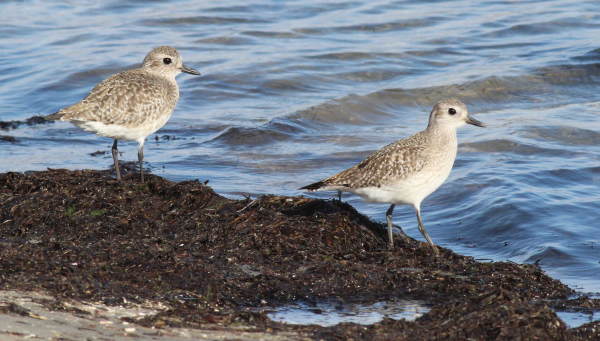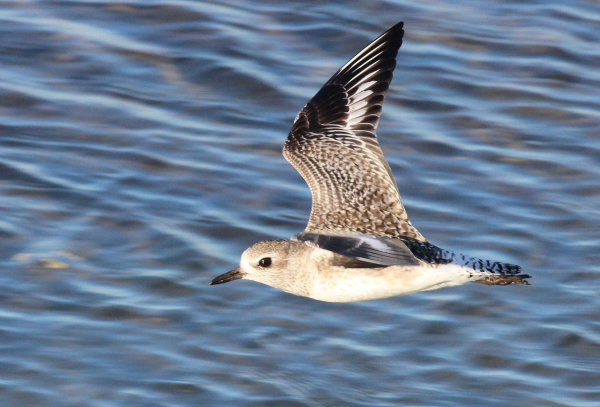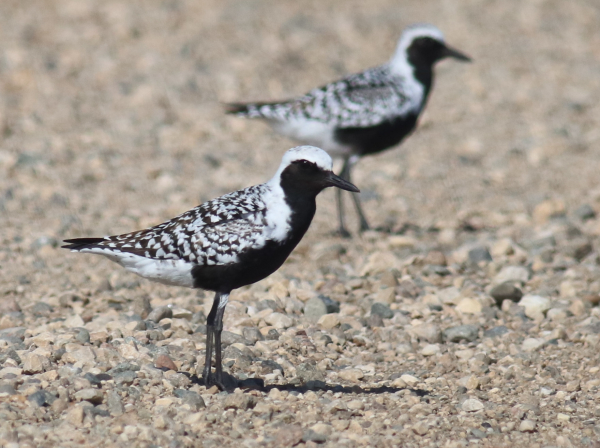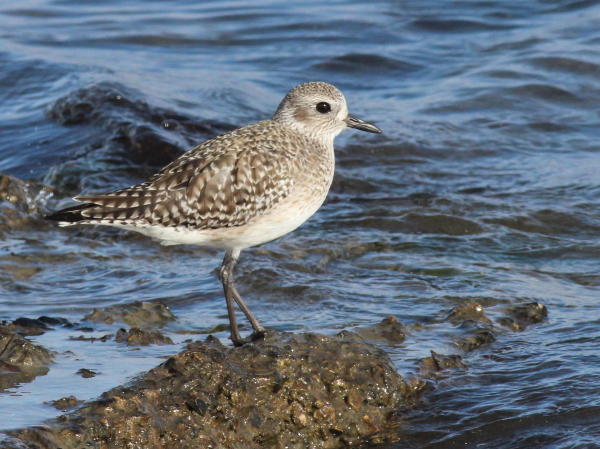Whenever you visit an ocean shore in America through fall to early spring, you have a good chance of seeing a Black-bellied Plover, or even a few of them. They are relatively wary and tend to be spaced out individually rather than in flocks, so they make good photo subjects if you’re up for a bit of a challenge. The immediate question may be how do you get close enough to get quality photos, and how can you portray these interesting plovers in action. The first thoughts you may have are to get a good portrait or two, a feeding photo, and flight photos – and that’s exactly right.

Although winter birds in basic plumage lack the namesake black belly, Black-bellied Plovers are handsome birds that attract many birders’ attention along wetland edges and beaches.
Getting close enough to take quality photos of a Black-bellied Plover can be a challenge in itself. Often, we see these winter gray plovers in the distance on the shore of a shallow open wetland or on a flat low-tide beach. My best results have been at locations where the plovers are limited to a shoreline, where they follow the waterline searching for small prey. It’s also always best to pick your location at a well-visited natural area where these wary plovers get accustomed to people passing by. This may happen at a popular beach or at a coastal wetland with walking trails; or you may find a trusting individual plover that either permits your relatively close approach or is comfortable enough to approach your stationary position as you sit or stand motionless at a location where you have seen these plovers following the water line in search of food.
Black-bellied Plovers usually don’t get much more than their toes wet; they prefer to stay on the edge of the water, or where water barely covers the sand or mud. Finding the right plovers and the right place to photograph them may take a bit of advance scouting and observations, but that’s always part of the fun. Plus, you will probably return repeatedly to try to get new photos of the birds in action. If you are making a short visit to a location that holds wintering plovers, for a couple hours or a couple days during a vacation, make the most of opportunities these interesting birds provide.

Black-bellied Plovers are known for their fast direct flight, which makes photographing these shorebirds in motion a real challenge.
Of course, while Black-bellied Plovers may be the focus of a birding trip or afternoon break, there will probably be many options for you to photograph other birds that use the same shallow-water wetlands, including other plovers, sandpipers, avocets, stilts, and godwits, plus wading birds including egrets and herons, not to mention terns and gulls, and even ducks. So enjoy all the photo ops and take advantage of all the birds that present themselves while you search for the next Black-bellied Plover to avail itself.
As always, try to use natural sunlight to your advantage, keep the sun behind you and your shadow pointing at your photo subjects. Focus on the birds’ eyes, try getting down on the birds’ level for some photos, and be sure to steady your camera and lens as best you can while holding your breath while pressing the shutter release button; and try not to disturb birds by approaching too close – allow them to fly on their own, but not as a result of your approach.

During late spring, Black-bellied Plovers molt into their dramatically different alternate plumage, but a lucky birder might get an opportunity to find and photograph a pair during a brief migration stop. Although the second plover is outside the field of focus in this photo, it adds a dimension to the bird that is sharply focused.
During winter, Black-bellied Plovers lack the rich black ventral plumage that provides the foundation for their name. Winter Black-bellies in their basic plumage tend to have a mottled gray and white coloration accented by a black bill, eyes, and legs. Their overall gray appearance best characterizes their Old World name – Grey Plover. Obviously, the American name came from a bird in alternate plumage, while the Eurasian species name came from birds in winter plumage.
Most of us don’t get to see these impressive fast-flying shorebirds in the splendor of their alternate nesting plumage, during late spring and early summer when Black-bellied Plovers nest and raise young on open expanses of Arctic tundra. Rarely do wintering Black-bellies exhibit black breast feathers in the Lower 48 or southern Canada.

A pleasing portrait of a wintering Black-bellied Plover may lack action, but it provides a classic photo of a classic shorebird in a pleasing setting.
I have a special connection with Black-bellied Plovers that makes me appreciate them more than most birders, but perhaps by bringing these interesting shorebirds to your attention, you will become a fan too. Of course, you may already have your own favorite plovers or sandpipers to lure you to wetland shores and beaches time and time again. If you’re lucky, you may even get to see and photograph Black-bellied Plovers in their dramatic alternate plumage in the latest stage of their migration north to the Arctic. Good Luck!
Article and photographs by Paul Konrad
Share your bird photographs and birding experiences at editorstbw2@gmail.com